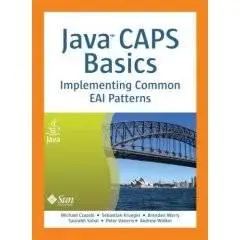Java CAPS Basics: Implementing Common EAI Patterns
Prentice Hall | May 3, 2008 | ISBN: 9780137130719 | English | 496 pages | CHM
Prentice Hall | May 3, 2008 | ISBN: 9780137130719 | English | 496 pages | CHM
Use Java CAPS to Streamline IT Services and Leverage Legacy Applications Designpatterns are a useful tool for streamlining enterprise integration andWeb development projects: the mission-critical projects that directlyimpact your competitiveness. Enterprise Integration Patterns byGregor Hohpe and Bobby Woolf (Addison-Wesley, 2004) described many ofthe most useful patterns for enterprise developers. Until recently,however, implementing the patterns in that classic reference requiredthe extensive use of raw Java code. Now there’s a better alternative:Using Sun’s Java Composite Application Suite (Java CAPS), architectsand developers can implement enterprise integration patternssuccinctly, elegantly, and completely.
In Java™ CAPS Basics,Sun’s own Java CAPS experts show how to quickly put these new tools andtechnologies to work in your real-world enterprise applicationintegration projects. After reviewing the challenges of enterpriseintegration, they introduce Java CAPS and show how it can simplify thedevelopment of today’s state-of-the-art “composite” applications. Next,they bridge the gap between abstract pattern languages and practicalimplementation details. You will learn essential Java CAPS concepts andmethods in the context of the patterns you’ll actually use forreal-world message and system management.
Coverage includes
* Comparingapproaches to enterprise application integration and finding ways tointegrate non-invasively, with fewer changes and lower costs
* Mastering the core integration tools provided by Java CAPS: eGate, eInsight, eWays and JMS
* Using enterprise integration patterns to improve application reusability, scalability, resilience, security, and manageability
* Implementing patterns for message exchange, correlation, infrastructure, routing, construction, transformation, and endpoints
* Generating and using cryptographic objects such as X.509 Certificates, PKCS#12, and JKS Keystores
* Using advanced techniques such as solution partitioning and subprocess implementation, many of which are covered nowhere else
* Constructing two complete example solutions that bring together many of the patterns discussed and illustrated in this book
Thecompanion CD contains detailed illustrations for most of the relevantpatterns and two complete Java CAPS-based case studies (with solutions)that implement a number of the patterns discussed in the book. Inaddition, Part II contains a chapter on cryptographic objects used toconfigure security-related aspects of the suite. It also provides morethan sixty detailed examples designed to illustrate the concepts andpatterns presented in this book. Built with JCAPS eDesigner, thesegraphical, component-based examples can easily be used by businessanalysts and others with or without strong coding skills.



